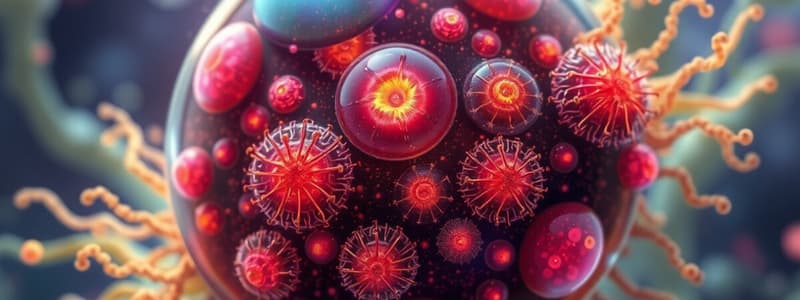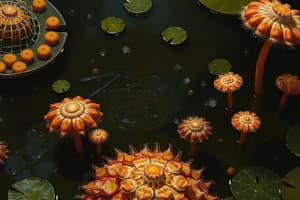Podcast
Questions and Answers
Which characteristic is common to both animal-like protists and animals?
Which characteristic is common to both animal-like protists and animals?
- They are both heterotrophs and ingest their food. (correct)
- They are both autotrophs.
- They both have cell walls made of chitin.
- They both obtain nutrients through photosynthesis.
How do fungus-like protists differ from fungi in their mode of nutrition?
How do fungus-like protists differ from fungi in their mode of nutrition?
- Fungi are autotrophs, while fungus-like protists are heterotrophs.
- Fungus-like protists ingest food, while fungi absorb nutrients.
- Both fungus-like protists and fungi absorb nutrients, this statement is incorrect. (correct)
- Fungus-like protists perform photosynthesis, while fungi do not.
What evidence from the Protista kingdom supports the endosymbiosis theory?
What evidence from the Protista kingdom supports the endosymbiosis theory?
- The existence of multicellular protists.
- The presence of chloroplasts in plant-like protists, similar to cyanobacteria. (correct)
- The aquatic habitat of most protists.
- The presence of nuclei in all protist cells.
A scientist discovers a new unicellular organism that is eukaryotic and photosynthetic. In which group would this organism likely be classified?
A scientist discovers a new unicellular organism that is eukaryotic and photosynthetic. In which group would this organism likely be classified?
Which of the following characteristics distinguishes protists from bacteria?
Which of the following characteristics distinguishes protists from bacteria?
Flashcards
What are protists?
What are protists?
Eukaryotic organisms that don't fit into the plant, animal, or fungi kingdoms.
What does 'eukaryotic' mean?
What does 'eukaryotic' mean?
Cells with a nucleus and membrane-bound organelles.
What are protozoa?
What are protozoa?
Animal-like protists that ingest food.
What are protophyta?
What are protophyta?
Signup and view all the flashcards
What is endosymbiosis?
What is endosymbiosis?
Signup and view all the flashcards
Study Notes
- Protists are eukaryotic organisms that don't fit into the plant, animal, or fungi kingdoms.
- They belong to the kingdom Protista and the domain Eukarya.
- Most protists are unicellular aquatic organisms.
- Eukaryotic cells have a nucleus and membrane-bound organelles, similar to human cells.
Types of Protists
- Protists are categorized into animal-like, plant-like, and fungus-like groups based on their similarities to other eukaryotic kingdoms.
Animal-like Protists
- Animal-like protists are heterotrophs that ingest food to obtain nutrients, similar to animals.
- They are also known as protozoa, meaning "first animals."
Plant-like Protists
- Plant-like protists ar autotrophs that perform photosynthesis to produce sugars and oxygen.
- They are also called protophyta, meaning "first plants."
Fungus-like Protists
- Fungus-like protists are heterotrophs that absorb food for nutrients like fungi.
- Unlike animals and protozoa, they externally digest food before absorbing nutrients.
Endosymbiosis in Protists
- Endosymbiosis involves one cell engulfing another, explaining the origin of chloroplasts and mitochondria in eukaryotic cells.
- Evidence within the Protista kingdom supports the endosymbiosis theory.
- The theory suggests mitochondria were engulfed first, followed by a photosynthetic cell (likely cyanobacteria) becoming the chloroplast.
- Red and green algae (protists) have DNA similar to cyanobacteria, showing an evolutionary link.
- Cyanobacteria is considered an evolutionary ancestor of both red and green algae.
Examples and Importance of Protists
- Protists have diverse examples and significant roles.
- Diatoms
- Unicellular protists with glass-like cell walls.
- Over 100,000 species exist.
- Plant-like and used in nanotechnology due to cell wall structure and small size.
Dinoflagellates
- Found in marine and freshwater environments
- Some species cause red tide by producing toxins that kill aquatic organisms.
- Some have mutualistic relationships with coral, while others are bioluminescent.
Euglena
- Can be autotrophic or heterotrophic depending on resource availability.
- Capable of photosynthesis when sunlight is available.
- Can consume and process nutrients when sunlight is limited.
Studying That Suits You
Use AI to generate personalized quizzes and flashcards to suit your learning preferences.




